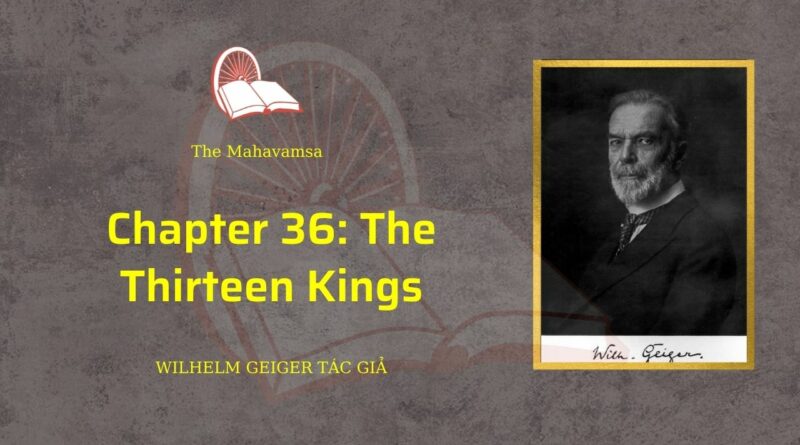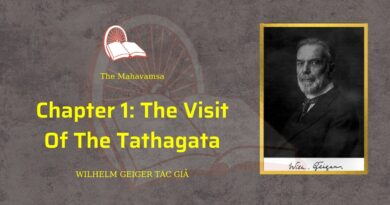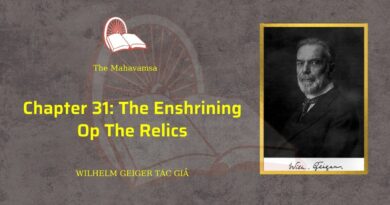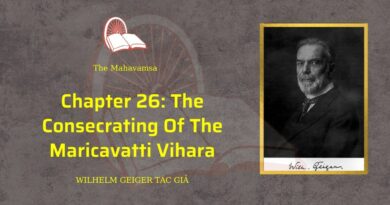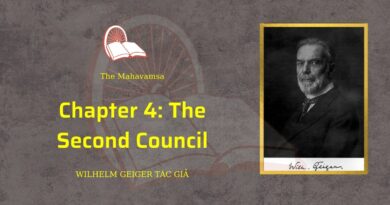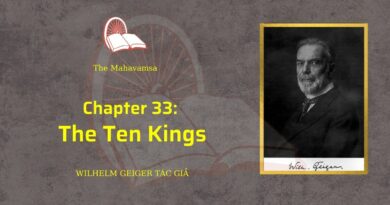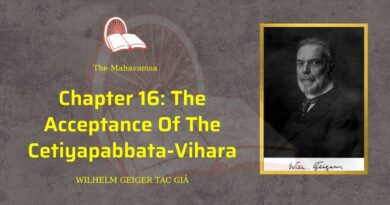THE MAHAVAMSA – CHAPTER 36: THE THIRTEEN KINGS
AFTER the death of MAHALLA NAGA his son BHATIKA TISSA reigned twenty-four years in Lanka. He built a wall around the Mahävihara. When the king had built the Gavaratissavihara lie made the Mahamani-tank and gave it to the vihara. Moreover, he built the vihãra called Bhätikatissa. He built an uposatha-house in the beautiful Thuparama; the king also made the Randhakandaka-tank. Filled with tenderness towards beings and zealous in reverencing the brotherhood the protector of the earth commanded lavish almsgiving to the community of both sexes.
After the death of BHATIKA TISSA (his younger brother) KANITTHA TISSA reigned eighteen years in the island of Lankä. Since he was well pleased with the thera Mahanaga in the Bhutarama he built for him in splendid fashion the Ratanapasada in the Abhayagiri. Moreover, he built in the Abhayagiri a wall and a great parivena and a great parivena besides in the (vihara) called Manisoma. In that place he built a temple for the cetiya and in like manner for the Ambatthala-thupa; and (he ordered) the restoration of the temple in Nagadipa. Doing away with the boundary of the Mahavihara, the king built there the row of cells (called) Kukkutagiri with all things provided. In the Mahävihãra the ruler of men built twelve great four-sided pasadas, admirable to see and beautiful, aria he added a mantling to the thupa of the Dakkhinavihara, and a refectory besides, doing away with the boundary of the Mahameghavana. And moving the wall of the Mahavihära to the side, he also made a road leading to the Dakkhinavihara. He built the Bhutaramavihara and the Ramagonaka, and the arama of Nandatissa besides.
In the east the king built the Anulatissapabbata (vihära) in Gangaraji, the Niyelatissarama and the Pilapitthivihara as well as the Rajamahavihara. In like manner he built in three places an uposatha-house, in the three following viharas, the Kalyanikavihara, the Mandalagirika, also the (vihära) called Dubbalavapitissa.
After KANITTHA TISSA’s death his son, who was known as KHUJJA NAGA, reigned one year. The younger brother of KHUJJA NAGA, KUNCHA NAGA, when he had slain the king his brother, reigned two years in Lanka. During the great Ekanalika famine the king maintained without interruption a great almsgiving appointed for five hundred bhikkhus.
But the brother of KUNCHA NAGA’s consort, the commander of troops, SIRI NAGA, became a rebel against the king, and when he was equipped with troops and horses he moved on to the capital and when he, in battle with the king’s army, had put king KUNCHA NAGA to flight, victorious lie reigned over Lanka nineteen years in splendid Anuradhapura. When the king had placed a parasol on the stately Great Thupa, he had it gilded in admirable and splendid fashion. He built the Lohapasada, keeping it within five stories (height), and he restored the steps to the four entrances leading to the great Bodhi-tree. When he had completed the parasol and the pasada he commanded offerings at the festival (of the consecration); great in compassion, he remitted the tribute of families throughout the island.
After the death of SIRI NAGA his son VOHARIKA TISSA reigned twenty two years, with knowledge of (the) law and (the) tradition. Because he first in this country made a law that set aside (bodily) injury (as penalty) he received the name king VOHARIKA TISSA. When he had heard the (preaching of the) doctrine by the thera Deva, who dwelt in Kappukagama, he restored five buildings. Moreover, contented with the thera Mahätissa, who dwelt in Anurarama, he commanded almsgiving in Mucelapattana. When the king VOHARIKA TISSA had set up a pavilion in the two great viharas and in the eastern temple of the great Bodhi-tree two bronze images, and had built also the Sattapannakapasada, goodly to dwell in, he appointed every month a thousand (pieces of money) for the Mahavihara. In the Abhayagiri-vihara and in the (vihära) called Dakkhinamula, in the Maricavatti-vihära and the (vihära) called Kulalitissa, in the Mahiyangana-vihara, in the (vihãra) called Mahagamanaga, in the (vihäras) called Mahanagatissa, and Kalyäriika he put parasols to their eight thupas. In the Mulanagasenapati-vihara and in the Dakkhina (vihara), in the Maricavatiivihära and in the (vihara) called Puttabhaga, in the (vihära) called Issarasamana and the (vihara) named. VOHARIKA TISSA in Nagadipaka; in these six viharas he put up a wall, and he also built an uposatha-house in the (vihära) called Anurarama. For the occasions when the Ariyavamsa was read he decreed over the whole island a regular giving of alms, from reverence for the true doctrine. With the spending of three hundred thousand (pieces of money) this king, who was a friend to the doctrine, freed from their indebtedness such bhikkhus as were in debt. When he had decreed a great Vesakha-festival, he bestowed the three garments on all the bhikkhus dwelling in the island. Suppressing the Vetulya-doctrine and keeping heretics in check by his minister Kapila, he made the true doctrine to shine forth in glory.
This king’s younger brother, known as ABHAYA NAGA, who was the queen’s lover, being discovered (in his guilt) took flight for fear of his brother and went with his serving-men to Bhallatittha and as if wroth with him, he had his uncle’s hands and feet cut off. And that he might bring about division in the kingdom, he left him behind here and took his most faithful followers with him, showing them the example of the dog, and he himself took ship at the same place and went to the other shore. But the uncle, Subbadeva, went to the king and making as if he were his friend he wrought division in the kingdom. And that he might have knowledge of this, ABHAYA NAGA sent a messenger thither. When Subhadeva saw him he loosened (the earth) round about an areca-palm, with the shaft of his spear, as he walked round (the tree), and when he had made it thus (to hold) but feebly by the roots, he struck it down with his arm; then did he threaten the (messenger), and drove him forth. The messenger went and told this matter to ABHAYA NAGA. And when he knew this, ABHAYA NAGA took many Damilas with him and marched from there against the city to do battle with his brother. On news of this the king took flight, and, with his consort, mounting a horse he came to Malaya. The younger brother pursued him, and when he had slain the king in Malaya, he returned with the queen and reigned eight years in the capital as king.
The king set up a vedi of stone round about the great Bodhi-tree, and a pavilion in the courtyard of the Lohapasäda. And obtaining garments of every kind for twice a hundred thousand (pieces of money), he distributed gifts of clothing among the brotherhood of bhikkhus on the island.
After ABHAYA NAGA’s death, SIRI NAGA II, the son of his brother Tissa, reigned two years in Lanka. When he had restored the wall round about the great Bodhi-tree, then did this king also build in the sand-court’ of the temple of the great Bodhitree, to the south of the Mucela-tree, the beautiful Hamsavatta and a great pavilion besides.
SIRI NAGA’s son named VIJAYA-KUMARAKA reigned for one year after his father’s death.
(At that time) three Lambakannas lived in friendship at Mahiyangana: Samghatissa and Samghabodhi, the third being Gothakabhaya. When they were coming (to Anuradhapura) to do service to the king, a blind man who had the gift of prophecy, being by the edge of the Tissa-tank, cried out at the sound of their footsteps: ‘The ground bears here three rulers of the earth!’ As Abhaya, who was walking last, heard this he asked (the meaning of the saying). The other uttered yet again (the prophecy). ‘Whose race will endure?’ then asked again the other, and he answered:
‘That of the last.’ When he had heard that he went (on) with the two (others). When they were come into the capital the three, being the close and trusted (counsellors) of the king, remained in the royal service about the king.
When they together had slain king Vijaya in his royal palace the two (others) consecrated SANGHA TISSA, the commander of the troops, as king. Thus crowned did SANGHA TISSA reign four years in stately Anuradhapura. He set up a parasol on the Great Thüpa and gilded it, and moreover the king put four great gems, each worth a hundred thousand (pieces of money), in the middle of the four suns,’ and put upon the spire of the thupa a precious ring of crystal. At the festival of (consecrating) the chatta the ruler of men distributed the six garments to the brotherhood (in number) forty thousand. As he (one day) when listening to the khandhakas’ heard from the thera Mahadeva, dwelling in Damahalaka, the sutta that sets forth the merit of (a gift of) rice-gruel, he, joyfully believing, distributed to the brotherhood at the four gates of the city an abundant and well-prepared gift of rice-gruel.
From time to time the king, with the women of the royal household and the ministers, used to go to Pacinadipaka to eat jambu-fruits. Vexed by his coming the people dwelling in Pacinadipa poisoned the fruit of the jambu-tree from which the king was to eat. When he had eaten the jambu-fruits he died forthwith even there. And Abhaya consecrated as king Samghabodhi who was charged with the (command of) the army.
The king, who was known by the name SIRI SAMGHABODHI, reigned two years in Anuradhapura, keeping the five precepts.
In the Mahavihara he set up a beautiful salaka-house. When the king heard that the people of the island were come to want by reason of a drought he himself, his heart shaken with pity, lay down on the ground in the courtyard of the Great Thüpa, forming the resolve: ‘Unless I be raised up by the water that the god shall rain down I will nevermore rise up from hence, even though I die here.’ As the ruler of the earth lay there thus the god poured down rain forthwith on the whole island of Lanka, reviving the wide earth. And even then he did not yet rise up because he was not swimming in the water. Then his counsellors closed up the pipes by which the water flowed away. And as he now swam in the water the pious king rose up. By his compassion did he in this way avert the fear of a famine in the island.
At the news: ‘Rebels are risen here and there,’ the king had the rebels brought before him, but he released them again secretly; then did he send secretly for bodies of dead men, and causing terror to the people by the burning of these he did away with the fear from rebels.
A yakkha known as Ratakkhi, who had come hither, made red the eyes of the people here and there. If the people did but see one another and did but speak of the redness of the eyes they died forthwith, and the yakkha devoured them without fear.
When the king heard of their distress he lay down with sorrowful heart alone in the chamber of fasting, keeping the eight uposatha vows, (and said): ‘Till I have seen the yakkha I will not rise up.’ By the (magic) power of his piety the yakkha came to him. To the king’s (question):
‘Who art thou?’ he answered: ‘It is I, (the yakkha).’ ‘Why dost thou devour my subjects? Swallow them not!’ ‘Give up to me then only the people of one region,’ said the other. And being answered: ‘That is impossible,’ he came gradually (demanding ever less and less) to one (man) only. The (king) spoke: ‘No other can I give up to thee; take thou me and devour me.’ With the words: ‘That is impossible,’ the other prayed him (at last) to give him an offering in every village. ‘It is well,’ said the king, and over the whole island he decreed that offerings’ be brought to the entrance of the villages, and these he gave up to him. Thus by the great man, compassionate to all beings, by the torch of the island was the fear pestilence brought to an end.
The king’s treasurer, the minister GOTHABHAYA, who had become a rebel, marched from the north against the capital. Taking his water-strainer with him the king fled alone by the south gate, since he would not bring harm to others.
A man who came, bearing his food in a basket, along that road entreated the king again and again to eat of his food. When he, rich in compassion, had strained the water and had eaten he spoke these words, to show kindness to the other:
‘I am the king Samghabodhi; take thou my head and show it to GOTHABHAYA, he will give thee much gold.’ This he would not do, and the king to render him service gave up the ghost even as he sat. And the other took the head and showed it to GOTHABHAYA and he, in amazement of spirit, gave him gold and carried out the funeral rites of the king with due care.
Thus GOTHABHAYA, also known as Meghavannabhaya, ruled thirteen years over Lanka.
He’ built a palace, and when he had built a pavilion at the entrance to the palace and had adorned it, even there did he daily invite a thousand and eight bhikkhus of the brotherhood to be seated, and rejoicing them with rice-gruel and with foods excellent and of many kinds, both hard and soft, together with garments, he bestowed alms lavishly upon them. Twenty-one days did he continue (to give) thus.
In the Mahavihara he built a splendid pavilion of stone; he renewed the pillars of the Lohapasada. He set up a vedi of stone for the great Bodhi -tree and an arched gateway at the northern entrance, and likewise at the four corners (of the courtyard) pillars with wheel-symbols.
At three entrances he made three statues of stone and at the south gate he set up a throne of stone. To the west of the Mahävihära he laid out a tract of land for exercises of meditation, and over the island he restored all ruined buildings. In the Thüparama he ordered the thupa-temple to be restored and also in the Ambatthala-monastery of the thera (Mahinda); and in the arama called Manisoma, and in the Thuparama, in the Manisomarama and in the Maricavatti (vihara), and moreover in the vihara called Dakkhina (he restored) the uposatha-houses. And he founded also a new vihära called Meghavannabhaya and at the (time of) festal offerings at the consecration of the vihära he distributed the six garments to thirty thousand bhikkhus dwelling on the island, whom he had assembled.
In like manner he appointed then a great Vesakha-festival, and yearly did he distribute the six garments to the brotherhood. Purifying the doctrine by suppression of heresy he seized bhikkhus dwelling in the Abhayagiri (vihära), sixty in number, who had turned to the Vetulya-doctrine and were like a thorn in the doctrine of the Buddha, and when he had excommunicated them, he banished them to the further coast. A bhikkhu from the Cola people, named Samghamitta, who was versed in the teachings concerning the exorcism of spirits, and so forth, had attached himself to a thera banished thither, and he came hither embittered against the bhikkhus of the Mahävihära.
When this lawless (bhikkhu) had thrust himself into an assembly in the Thuparama and had refuted there the words of the thera living in the parivena of Samghapala, namely the thera GOTHABHAYA, uncle of the king on the mother’s side, who had addressed the king with his (old) name, be became a constant guest in the king’s house.’ The king who was well pleased with him entrusted his eldest son Jetthatissa and his younger son Mahasena, to the bhikkhu. And he made the second his favourite, therefore prince Jetthatissa bore ill-will to the bhikkhu.
After his father’s death JETTHA TISSA became king. To punish the hostile ministers who would not go in procession with him, at the performing of the king’s funeral rites, the king himself proceeded forth, and placing his younger brother at the head and then the body following close behind, and then the ministers whilst he himself was at the end (of the procession), he, when his younger brother and the body were gone forth, had the gate closed immediately behind them, and he commanded that the treasonous ministers be slain and (their bodies) impaled on stakes round about his father’s pyre.
Because of this deed he came by the surname ‘the Cruel’. But the bhikkhu Samghamitta, for fear of the king, went hence at the time of his coronation, when he had taken counsel with MAHASENA, to the further coast awaiting the time of (MAHASENA’s) consecrating.
He (JETTHA TISSA) built up to seven stories the splendid Lohapasada, that had been left unfinished’ by his father, so that it was now worth a koti (pieces) of money. When he had offered there a jewel worth sixty thousand, Jetthatissa named it the Manipasada.
He offered two precious gems to the Great Thüpa, and he built three gateways to the temple of the great Bodhi-tree. When he had built the vihara Pacinatissapabbata the ruler gave it to the brotherhood in the five settlements.
The great and beautiful stone image that was placed of old by Devanampiyatissa in the Thuparama did king Jetthatissa take away from the Thuparama, and set up in the Arama Pacinatissapabbata. He bestowed the Kalamattika-tank on the Cetiyapabbata (vihara), and when he celebrated the consecrating festival of the vihära and the pasada and (held) a great Vesakha-ceremony he distributed the six garments among the brotherhood, in number thirty thousand. Jetthatissa also made the Alambagama-tank. Accomplishing thus many works of merit, beginning with the building of the pasada the king reigned ten years.
Thus, reflecting that sovereignty, being the source of manifold works of merit, is at the same time the source of many an injustice, a man of pious heart will never enjoy it as if it were sweet food mixed with poison.

